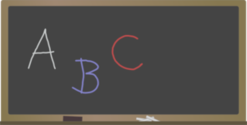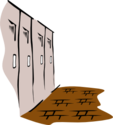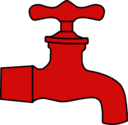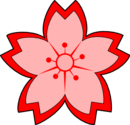Chokai ALT
2012-02-09
Dear new ALT, you'll be coming to Chokai! This is good news, because Chokai is a great place to work and live. Here's some information for you.

About Chokai
Chokai (鳥海町) is a town in the city of Yurihonjo (由利本荘市), which is in southern Akita prefecture. Technically speaking, "city" and "town" are political units based on population, so though it's called a city, much of Yurihonjo is rural. You can drive for 60km and still be in the same city! Yurihonjo is divided into towns, and the two of these most relevant to you are Chokai and Yashima (矢島町), where your schools are located. For information on Yurihonjo, see Wikipedia or the AkitaJET wiki.
The urban center of Yurihonjo is called Honjo, and it has large supermarkets, City Hall, and all sorts of businesses. Chokai is far from Honjo — a 30-60 minute drive, depending where you want to go. Chokai itself is composed of villages and hamlets, the most notable of which are Kawauchi, Jinego, and Hitane. For pictures, see Wikimedia Commons or my photo gallery. For other relevant information, see elsewhere on my website.

Schools
The position I had, which you'll have, is an elementary and junior high school ALT. There are five schools: Yashima Junior High School (矢島中学校), Chokai Junior High School (鳥海中学校), Hitane Elementary School (直根小学校), Jinego Elementary School (笹子小学校), and Kawauchi Elementary School (川内小学校). Yashima JHS is in Yashima, and the other four schools are in Chokai. Number-wise, there are only four schools in Chokai, and you'll work at all of them. There are three schools in Yashima, and you'll work at one of them (the other two are Yashima Elementary School and Yashima High School). For more on these schools, see the AkitaJET wiki. When you first visit the schools, they may or may not explain to you the general rules for teachers. As I remember it, here are the rules they told to me (with side comments in italics).
- Your work day is 8:00-4:00. In rare cases, you'll work after 4:00, but most of the time you should not do so, because it is neither in your contract nor a good use of your time. After 4:00 you can leave. If you want to stay at school, you can help out with, join in, or go watch a club activity. When and how to go about this is up to you. Participating in club activities is great use of your time — you'll learn a lot, you can play sports if you like, and the impact on the students is large. Unfortunately, ALTs cannot be official coaches of sports teams, but you can help out in practice, either occasionally or regularly, if the coach is OK with it.
- Except where noted, you work Monday through Friday. There is no school on national holidays. On occasion, there is a special event on a Saturday or Sunday, and if so, there will be a comp day around that time. Because you visit multiple schools, sometimes your comp day won't be the same as the rest of the school (i.e., the day they took off is a day you went elsewhere). If this happens, you should ask that school when they want you to take the comp day. Also, because you visit elementary schools rarely, they can't always give you a comp days for a special event. If an event is not on your work calendar, you can go to it in your free time if you like, but this is entirely up to you, and even if you go (because it looks fun), you don't have to stay the whole time.
- If you are going to be significantly late for work, call the school and tell them. If you unexpectedly can't go to work for some reason, call Chokai Junior High School, even if you are scheduled to visit another school. They will relay the information. If you're taking a sick day, it's generally expected that you'll go to (or have recently gone to) the hospital. Also, traditionally you should be talking to the vice principal if you can't make it to school, because the vice principal oversees this kind of thing. If your Japanese is not up to speaking with the vice principal on the phone, you can talk to an English teacher instead, and then the next time you go to school, briefly talk with the vice principal about why you were gone. If you're unexpectedly absent for several days in a row, contact the school each morning. If you get sick and need to go to the hospital, I recommend talking with the school. The school nurse can recommend a hospital to visit, and the school can call ahead and make sure the hospital is prepared to receive you. If needed, the school can send an English teacher with you to help translate. For work-related communication regarding matters such as these, it is best to use the telephone to call the school directly (unless it's after hours or you've arranged otherwise). Emailing the English teacher's cell phone is a bad idea.
- At school, your direct supervisor is the vice principal. For academic matters, your English teacher is in charge. For scheduling matters, there is a teacher in charge of scheduling for the entire school who makes your calendar. If you want to bring an outside guest to school, you need advance permission (which you can probably get) from the principal.
- Technically speaking, you are a public servant (公務員; kōmuin), like the secretary and the maintenance man, and you work for the town. Other teachers at school work for the city. This means that you won't change schools between years (other teachers transfer schools every few years), your paperwork is different from other teachers', and the holidays you have might be slightly different.
- You should wear presentable clothing every day. Something like what the other teachers wear is reasonable. For graduation and commencement, you should wear a suit or something comparable. For Sports Day, you should wear something suitable for running or sports. Many of the teachers wear ties and suits on a regular basis. Unless the vice principal or principal tells you to do this, you don't need to be so formal.
- Your teaching responsibility is to do team teaching for English lessons. At junior high school, you'll work with an English teacher who generally plans most of the lessons. At elementary school, first through fourth grade lessons are part of the period for integrated study, which means there is no textbook or syllabus, so you should confer with homeroom teachers about what topics to cover. For fifth and sixth grade, there is a textbook and syllabus. Elementary school teachers are not English experts, so there's room for you to do quite a lot. Your first lesson will likely be a self-introduction lesson. Strictly speaking, you are not supposed to be teaching alone, though if your fellow teachers feel that you can, you might occasionally do so. It is likely that you'll do most of the work for first-fourth grade elementary school classes.
- During summer vacation, you'll coach junior high school students for the annual speech contest. The English teachers will oversee this, though perhaps your instruction will be the most significant.
- You must pay for school lunch. Typically, you can pay at the end of the term. A day's lunch is something around ¥300. School lunches are very large, so maybe small breakfasts are in order.
- You might be asked to pay into a teachers' coffee/tea fund. Coffee and tea are available as much as you like in the staff room. They might ask for ¥500-1000 a month. If they never ask you to contribute, you don't need to. Either way, you can have coffee.
- Try to use supplies from a school at that school. A common complaint from junior high schools is that ALTs use a lot of color toner or make dozens of photocopies in preparation for an elementary school visit, which means the junior high school is paying for the elementary school's supplies. This upsets the office person at the junior high school, which is not a good thing. Using school supplies for personal use is not permitted. You will probably do prep work for elementary school at junior high school. Just keep an eye on not using too many materials. If you occasionally use a color printer to print something for another school, nobody will worry about it. But if you want to do a lot of laminating, ask the destination school to order you a box of laminating paper (which you can use wherever you like). Similarly, if you know you need a lot of supplies for elementary school, get them ahead of time from the elementary school. When preparing for work-related conferences, anything involving the education office, or similar work-related events, feel free to use materials from whatever school you're visiting.
- Student privacy is very important. Students' test scores and health are things that you shouldn't talk about with third parties. If you want to use closeup pictures or videos of students on your public blog or on YouTube, you must get permission from their parents (which is to say, you generally can't). Distance shots are fine, though.
I've made a file that has a lot of useful information like maps, teachers' names, rosters, and other such materials. It will be in your desk when you arrive at Chokai Junior High School. Learning the names of teachers and students is very important — it would be hard to overemphasize how much this matters. There are also some JET Program publications from past years which might be of interest. At both Chokai and Yashima, there's a computer at your desk. You can use it to surf the internet for lesson plans, to check email, and to read the news. If you're just wasting time on the internet, try to be slightly discreet. All school internet traffic goes through a city proxy server, and while presumably nobody monitors what sites you're visiting, they could if they were so inclined. On this blog, there are entries with pictures and history for each of the five schools (Chokai, Yashima, Jinego, Kawauchi, Hitane). Chokai Junior High School's phone number is 0184-57-2309. The address is 〒015-0504 秋田県由利本荘市鳥海町上川内字西野108, or in English, Nishino 108, Kami Kawauchi, Chōkai, Yurihonjō, Akita 〒015-0504 JAPAN.

Education
Education is a broad topic, and because we as ALTs often lack prior experience in the field, we have to learn a lot on the fly. The two most important sources of written information are the JET Program and the Ministry of Education, Sports, and Technology (MEXT). When you arrive in Japan, you'll probably get a copy of the national Course of Study for elementary and junior high school English. It is worth reading this document several times, because it highlights the assorted objectives of the classes you will teach. In junior high school, English classes are taught by a certified English teacher (JTE). When you are there, you'll do team teaching (TT). Different JTEs have different styles, but most of them are very open to ideas you might have. A common difficulty that new ALTs have is that their activities are too complicated and thus take too long or are otherwise confusing, so if you're suggesting an activity to your coworkers, try to keep it simple. If you feel underused at junior high school, recognize that as you gain experience and knowledge, and as you and the JTE adjust to working together, you'll be able to do more. Also, there are many things you can do outside of class to interact with the students. For example, you can make an English poster board, do English writing journals, or play foreign music during lunch time. At elementary school, fifth and sixth grade students study English as part of the course called Foreign Language Activities. The objective of this course is using English, specifically in verbal form. Fifth and sixth grade teachers teach English even when you aren't there, so you'll probably do lesson planning with them by fax or email. The JHS English teachers can help translate faxes or emails. There's a textbook for fifth and sixth grade too — the Eigo Note. There is an electronic copy of the Eigo Note on your JHS computer. For first through fourth grade elementary school, English is part of the Period for Integrated Studies, which means there's no syllabus and no textbook. This also means you have a lot of freedom to choose interesting topics. The simplest way to plan first through fourth grade lessons is to pick a topic for each class (for example, fruit). In that class, teach the students roughly ten new words (apples, peaches, oranges, etc.). Play a few games to practice the vocabulary. Then end with a conversation game that uses a simple question and answer pattern (shopping for fruit, say). As you get comfortable with elementary school lessons, you can integrate short reviews of the previous class's material or to cover multiple topics. Expect students to forget a lot, because you're only teaching them once a month. For all students, and particularly younger students, activities where they move their bodies are a great idea. Two simple examples of this are Total Physical Response (TPR) and having students lie down to form numbers, shapes, or hands on a clock with their bodies. Homeroom teachers at elementary school generally don't speak much English, which can make team teaching somewhat difficult, but you should try to work with them closely, because it will make your classes smoother. To begin with, they probably have ideas for what topics or games their students might like to play. Beyond that, any time you are showing examples, you can show them with the homeroom teacher, though it would be good to chat with the homeroom teacher before class so they know what kind of example you want. Generally speaking, for first through fourth grade, the best lessons are fun, simple, and fast-paced. It is said that kids have an attention span that's about as long as their age, which means, for example, that six-year-olds should probably be starting a new activity — or changing the current activity — every six minutes or less. I don't know whether psychology research supports this rule of thumb, but that doesn't really matter, because if you keep it in mind when planning lessons, you'll find your lessons will be well received.

Annual events
All schools have an annual Sports Day (運動会). Chokai JHS and Yashima JHS tend to have theirs in May, and the elementary schools tend to have theirs in June or July. At Sports Day, students split into teams and have both serious and fun races. There are also some events for teachers and PTA members. At Hitane Elementary School, the Sports Day is a community event, not just a school event, so there are also events for grandparents. In the fall, elementary schools have a School Presentation Day (学校発表会), and junior high schools have Culture Festival (文化祭). The elementary schools have a few academic presentations followed by a chorus or band concert. In the afternoon of that day, some schools have special events. For example, Hitane Elementary School does soba making, and Jinego Elementary School sometimes does mochi making. At the junior high schools, the event is an all-day affair. Classes compete in the chorus contest, some recite speeches, others may do a dance or performance, the school band performs a few numbers, and other interesting things may happen. There are three annual sports tournaments: spring (late April), summer (late June or early July), and autumn (late September). Various sports use different venues in the Yurihonjo-Nikaho area. Typically, baseball is the most popular, and if the baseball team wins the city tournament, the whole school will probably go cheer for them at the prefectural tournament. The English Speech Contest is held in the fall, and two students from each junior high school can join. Auditions might happen just before summer vacation, and the bulk of practice takes place in August, during summer break. In March, teacher transfers are announced. Teachers (and other workers) tend to change offices every two or three years, as decided by the Board of Education. They typically get the news in late March and start at their new place of work in April. Still, sometimes teachers stay at a school for many years — there is no official limit. Retirement age is sixty, and teachers in Akita are required to retire when they reach that age. Students who transfer schools are most likely to do so at the end of the academic year, in late March.

The Board of Education
The Yurihonjo Board of Education (由利本荘市教育委員会; Yurihonjō Kyōikuiinkai) office is in Honjo, and it is in charge of all elementary and junior high schools in Yurihonjo. You won't visit the Board of Education much. Instead, you will be supervised by the Chokai Education Office (鳥海教育学習課; Chōkai Kyōiku Gakushuka), which is a branch of the Yurihonjo Board of Education. At the moment, the guy who signs your contract is the head of the Chokai office, Mr. Sato Kakuei (佐藤 覚栄), though he might be retiring this March. He is in charge of elementary school and junior high school education for Chokai, but in reality he doesn't have much to do with the ALT directly. Instead, one of the other office workers at the branch office will handle your paperwork. Generally speaking, your schools determine your schedule — Chokai Junior High School is your main school, so if you want to change your schedule, talk to them. The education office wants to know where you've visited because they pay a portion of commuting costs, so please keep track of what schools you went to on what days. And at the end of the semester or school year, they might also want to know how many times you taught each class, so try to keep track of this. If you're going to a distant place on vacation (especially if it's international), you should probably tell the education office where you're going, how long you'll be there, where you're staying, and how they can contact you in case of emergency (ideally, email and a phone number). When I went on international trips, I found it convenient to make a printout of my itinerary, give a copy to Chokai Junior High School, and put a second copy in my desk at the education office. Probably nobody will ever need this information, but in rare cases it matters, and regardless it's a professional gesture. Nobody speaks much English at the office, so if you have something complicated to convey over the phone (like some kind of emergency situation), it might be a good idea to call the junior high school and speak with an English teacher there. If you go in person, you can use online translation websites. The education office will help you with many logistical things, including: picking you up when you arrive, taking you to your schools the first time you go to them, buying a car, getting car insurance, paying car and income taxes, getting a hanko (a stamp), getting a bank account, showing you your housing (which they manage), getting internet (optional), getting cable TV (optional), getting a cell phone, your transportation allowance, how to pay bills, renewing or ending your contract, informing you of upcoming conferences, and anything else like this. For the first few days after you arrive, you'll be at the education office all day. During this time, you'll visit each of your schools once and meet the principals and English teachers. Then you'll have a short welcoming ceremony at Chokai Junior High School, and from that day on, you'll go to school every day. I typically visit the education office once a week for about half an hour so I can chat with the staff there, pick up unpaid bills, put paid bills in an envelope for safekeeping, and do any necessary paperwork. Visits to the education office are part of your job, so you can visit during working hours — ask your school for permission to go during some free time. The Chokai Education Office's phone number is 0184-57-3020. The address is 〒015-0592 秋田県由利本荘市鳥海町伏見字久保193, or in English, Chokai Education Office, 193 Kubo, Fushimi, Chokai, Yurihonjo, Akita 015-0592 JAPAN.

Housing
There is teacher housing in Jinego (笹子), a village of Chokai. Teacher housing is called kyouin juutaku (教員住宅) in Japanese. Your house is a duplex, but the common wall you share with your neighbor is your garage, so noise won't be a problem. You have a garage, which is rare and nice. The house is relatively large, in comparison with other ALTs' places in Honjo, and because it's owned by the town, rent is cheap. You'll have to pay rent, electric, water, propane (for cooking), and kerosene (for hot water). For internet, I used YB Net's fiber, and if you use it, your setup costs should be very low, because the house is already wired. There are a few other internet providers available. Probably you'll use JA Bank, which is technically an agricultural cooperative (this distinction matters for obscure paperwork). There are branches of JA Bank all over Chokai (and Japan generally), and you can use any of them. Sato Toshinobu Shoten fills your propane on a regular basis, but they only fill your kerosene tank (in the back of the garage) when you ask them to. If you run out of kerosene, you'll have no hot water, so when the tank gets slow, either call or go to the store and ask for a refill. There's a very powerful kerosene heater in the living room. You'll have to buy kerosene at the gas station or hardware store and fill the tank by hand (using the two red plastic 20L kerosene containers). The air conditioner can produce heat, and there's a portable electric space heater, but using electricity to heat your entire house on a regular basis is not economical in winter. In case of a power outage, there's also an old kerosene space heater in the garage which doesn't use electricity. Also, water and gas are not affected by power outages. In a power outage, house phones won't work, but the local cell towers have batteries that last for 5-10 hours. The apartment is fully furnished, including: a bed, several futons, sheets, blankets, a kotatsu, all of the standard things you'd need in the kitchen, a washing machine, a dryer, shovels (for snow), and some other stuff. There is an old TV that the education office might replace, though they haven't decided yet. Of the above items, most of them came with the place when I moved in, but over time, things wear out and need to be replaced. If anything big breaks — the air conditioning, the stove, a window, etc. — contact the education office and they can deal with it. For cheap small things like pillows or floor mats, you're better off replacing them on your own as needed. There is some parking next to the house for guests, and when that is full of snow in the winter, people can park at the rest area 200m away. There's also a small police branch station next to the house. A police officer lives there, and the building has a small office, but he typically works at the Yashima Police Station, so you might not see him around very much.

Bills
Generally speaking, there are five ways of paying bills: automatic payment from bank account, in cash at the provider's office, by bank transfer at an ATM, in cash at a bank, and in cash at a convenience store (i.e., Lawson). Here are some of the different bills I have and how I pay them.
- Rent. Your housing is managed by the Chokai Education Office. They'll leave monthly bills in your desk at the office, and you can pay those in cash at a bank counter. These payments can only be done on weekdays before 4:00. It is possible to go to the bank during free time at school — ask the vice principal for permission.
- Internet. I had YB Net internet service and did automatic payment.
- Gas. Kerosene (for hot water) and gas (propane, for cooking) and are provided by Sato Toshinobu Shoten (佐藤寿信商店), a small general store located on main street in Jinego. They'll leave bills in your mailbox, and you pay bills in cash at the store itself. The phone number is
0184-59-2020, and it's located at39.10632, 140.291444. - Electric. From Tohoku Denryoku (東北電力). I did automatic payment.
- Cell phone. I used Docomo and did direct payment. The other major carriers no doubt support this, too.
- Car insurance #1. Primary insurance, which is required, comes through the town office. You'll get the same excellent price that other Yurihonjo municipal servants get. This insurance is paid on rare occasion ... either once or several times a year.
- Car insurance #2. Supplementary insurance, if you purchase it, is also paid on rare occasions ... either once or several times a year.
- Car registration. Paid each spring, or if you buy a car later in the year, probably not long after you buy your car. It is very important to keep receipts (in postcard form, probably) for car registration payments.
It is a good idea to keep your old receipts. You can put them in an envelope and leave that in your desk at the education office. If there is some billing situation that you don't understand or are worried about, talk to the people at the education office, and they can probably explain things more clearly.

Water
Hot water in the house comes from the water heater, which is located in the garage. If you want to use hot water for the sink in the kitchen or bathroom, you need to turn it on. There's a white box on the wall in the kitchen, and if you press the large button on it and run the tap for 10 seconds, you'll get hot water. There's a little box in the bathroom for the shower and bath. If you press that button once, the light will turn on, and you'll get about two minutes of hot water until it automatically shuts off, at which point you'll need to press it again (and if you forget, the blast of cold water should remind you). If you fill up the bathtub 20% or so, the hot water will stay on, and you won't have to keep pressing the button. The washing machine runs entirely on cold water, so you might want to bleach your whites on occasion. In the winter, temperatures will drop below zero, and if you're gone for several days, your pipes could freeze and burst, and that would cost you a lot of money. So if you're leaving your place for several days, you should turn the water off. This can be done by closing the two floor valves (one in the kitchen and one in the wash room) and opening all of the faucets. There is no need to fiddle with the water heater in the garage. If you're only leaving for one night, perhaps you don't need to turn the water off. I've forgotten to turn the water off many times, and it's never been a problem for me. There's also a faucet for a hose by the stairs in front of the house. In the fall, shut off the water to this faucet by turning the knob on top with a wrench and then opening the faucet. In the spring, get your wrench back out, turn the knob the other direction, and turn the water back on.

Trash
Burnable trash days are Monday and Friday. Recycling and non-burnable trash day is Wednesday, but not every Wednesday, and what they collect varies by week. Trash pickup is sometime between eight and ten in the morning. I generally look Wednesday morning to see what they're collecting and then drop that off. If a trash day is a national holiday, it is skipped. If you only have a small amount of recyclables, you could take them to the convenience store. The trash collection point is halfway between the Jinego Police Station and the traffic light. There are two small sheds by the side of the road. Usually, the one closer to the police station is for burnable trash and the one closer to the traffic light is for recycling, but if one were full, you could freely use the other one. People generally take out their burnable trash the morning of trash day, but it's fine to take yours out the night before. Taking your trash out several days in advance is not generally recommended, but you can do so on occasion if you like. There are three kinds of trash bags: yellow for burnable, blue for non-burnable, and something else for recyclable that you don't need. These can be purchased at any local store. You should write your name on the trash bag before taking it out. Write your name in katakana, and for the location, write 下野 (Shimono). Objects larger than trash bags cannot easily be thrown out, so think carefully before buying large objects. In Chokai (unlike Honjo, perhaps), you don't need bags for recycling. There are large plastic bins that people put by the collection point the morning of recycling pickup, and you should put your recyclables into the bins directly.

Things to bring
There's a nice list of what to bring on the AkitaJET website. Most of what you'll need or want is mentioned there. Additionally, make sure you bring your driver's license and a lot of pictures (both digital and print is best) of things in your daily life at home. Otherwise, whatever you feel like bringing should be fine.

Transportation
The public bus service in Chokai will be largely discontinued March 31, 2012. It seems a van service from Jinego to Fushimi (near Chokai JHS) is set to replace the buses, though the details aren't public yet. Probably the van service will pick up riders at the Jinego Rest Area, where they will also post a time table. There are no trains. You'll need to buy a car. Some people in northern Akita lease cars, apparently, but I don't know of any places in southern Akita that have reasonable leasing deals. There's a lot of snow in the winter, so getting front wheel or four wheel drive is wise. Because of the large volume of snow in the winter, small light kei cars (with yellow license plates) are not recommended, because if a road or parking lot hasn't been plowed or shoveled, you'll get stuck. And you probably won't find any reasonable deals on used kei cars. If you're looking to save money, a small-ish sedan or hatchback is a good way to go. The simplest way to purchase a car is from one of the dealers in Honjo. Dealers are more expensive than private car lots, generally speaking, but they can offer very good service, which matters when your car breaks down 30km from the garage. If you buy a car from another ALT who is selling one, you can probably save even more money, but make certain to get extensive photography and a history of maintenance, accidents, repairs, and car inspection — it's bad for everyone if you commit to buying a car when you don't really know what kind of shape it is in. In the winter, you'll need snow tires. Large snow tires are significantly more expensive than small ones. You'll no doubt buy a cell phone. If you get a smart phone, you can use its maps. It's good to think about cell coverage and GPS. iPhones don't have real GPS — they use cell towers to determine location — so they are not as precise in the countryside, which is slightly inconvenient. Androids tend to have real GPS. Perhaps you'll want to buy a road atlas from a gas station or bookstore, in case you're driving in the boonies. For finding obscure places in Yurihonjo, OpenStreetMap and Google Maps) are quite nice.

Recreation
There are a great many things to see and do in Chokai and Japan in general. Within Chokai, the most famous things are skiing (Yashima Ski Area), hiking (Mt. Chokai), and onsen (Foresta Chokai or Chokaiso). There are some adult baseball, basketball, indoor soccer, and volleyball teams. There's also a taiko drumming circle. At small local festivals, you might help carry a float, if you want to. Honjo and Yuzawa are a bit of a drive, but they have a lot more people and thus a lot more opportunities. Traditional Japanese pursuits like karate, judo, aikido, flower arranging, and Japanese musical instrument playing can be found, and taking up a Japanese hobby is a good way to meet people and learn more about Japanese culture. There are non-Japanese pursuits in abundance, as well. The easiest way to find out about things is to ask other ALTs. If they don't know (or even if they do), try talking to teachers at school. It might be necessary to talk to many teachers, though, so don't be shy about information gathering. You can also travel both in and out of Japan. There are direct flights from Akita to Korea. For other international travel, you'll probably go through Tokyo. The easiest way to get to Tokyo is via shinkansen (high speed train) from Shinjo. You can drive to Shinjo and leave your car there for up to a month. See Hyperdia for train time tables and fares. There may also be relevant information on Wikivoyage.

Shopping
The Jinego A-Coop, a small grocery store, is at the traffic light near the house, and it's open until 7:00. Conbini Sato is on Highway 108 about 3km NW of the house, and it's open until 9:00 or 10:00. The nearest large supermarket is the Max Valu in Yashima. For general purpose shopping, there are Aeon Supercenters in Yuzawa and Honjo. For foreign food, the nearest places are in Akita City and Shinjo. Ugo, a short drive down Highway 57, has a small shopping center, though most people who live in Jinego would spend an extra ten minutes going to Yuzawa. Online shopping can be handy — Amazon Japan has English on it. If you're occasionally getting packages sent to you from Amazon or overseas, having them delivered to school or the education office is a good idea, because if you aren't home to sign for a box, you'll have to call the shipping office back and arrange a delivery time. Nobody really knows why, but clothes in Japan are often sold for the coming season, not the current one, so if you wait until August to buy a swimsuit, for example, they might not have many left on the shelf. Dry cleaning takes a long time in rural areas, because they take the clothes by van to Honjo or Yuzawa, and that adds a few days to the process. Maruyasu Shoten in Kawauchi has the best hours in Chokai, and it's close to Chokai Junior High School. They might give you tea and snacks if you chat with them for a while, too. The dry cleaning place in Jinego, downstairs from Time and next door to Sato Toshinobu Shoten, is a short walk from the house, and their prices are comparable. In terms of clothes sizes, even those wearing XXL can find stuff to buy. If you have large feet, though, the local footwear selection might be limited or nonexistent.

Contact
Once you arrive and get an alien registration card, you can get a cell phone, and you'll want to do so (the alien registration card system will change in July, 2012, and the rules about getting a cell phone might change, too). In terms of cell coverage, Docomo cell towers cover the most area, but Docomo is quite expensive. The three major carriers (Docomo, AU, and Softbank) can be used at the house and the schools in Chokai, so many locals use Softbank and AU despite the smaller coverage area. Though data plans are pricey, ALTs tend to get smart phones. If you want to travel a lot within Japan, the maps and web browser of a smart phone will come in handy, since for much of Japan the best travel guide resources are online. Despite having internet access at school, you probably want to get internet at home, because, among other reasons, VOIP (e.g., Ekiga, Skype, or Google Talk) is the cheapest way to make international phone calls. The education office can help you figure out your choices and who to talk to for setup and installation. Japanese people tend to have email on their cell phones, and some of them set their cell phones to block non-cell phone email, which is inconvenient if you want to use your regular email account exclusively. Though some teachers have adapted to email, many are more comfortable with faxes, and official school communication is typically sent by fax or post. You can get cable or satellite TV, but I didn't bother, because you can rent DVDs, and English-language news is available online, so the only big thing missing, in my view, is Japanese sports coverage. And if you want to watch sports, you can go to a restaurant, bar, or friend's house anyway. Japanese postal service is blindingly fast. Packages travel within the country in two days, routinely. When sending boxes to the U.S., air mail is expensive but fast (less than a week, typically). Sending packages by boat is cheap but slow (think months). Letters and post cards always go air mail ... I don't know if it's possible to send them by sea even if you wanted to.

Alcohol
If you get caught drinking and driving (and the legal limit here is around zero), you'll be sent home. That's pretty horrible, so getting a personal breathalizer is a good idea if you plan on drinking much. The cops are known to look for people sleeping in their cars after a night on the town and pull those people over the next morning, and they would be very happy to give a DUI to a civil servant (it's a police pride thing). If you wake up in the morning and realize you aren't fit to drive to school, either take a taxi or call the school and ask them if you can come to work a few hours late. Getting a ride to school from another teacher might be possible, too. Certainly other teachers at your school will occasionally carpool or show up late because of drinking, though you might not notice, because it's discussed quietly. While missing work because alcohol's still in your system isn't ideal, the fact that you are responsible enough to stay off the road reflects well on you, as long it's a rare thing. One of my acquaintances here in Akita got a DUI several years ago — out drinking at night, pulled over the following morning, failed a breathalizer — and we were quite sad, but there was nothing to be done about it. Putting a change of clothes in your car is a nice idea, whether or not you drink much. That way you can stay over at someone's place (if you have a beer or if the weather is bad) and not have to drive home in the morning before going to work. Staying over at someone's house is a fairly common thing in rural Akita. Daiko is expensive, taxis are ridiculously expensive, and houses in the countryside are large enough where putting you up for the night is easy to do.

Japanese
If you want to study Japanese while you're in Japan, you'll have plenty of chances. To begin with, the JET Program will probably give you some materials. Additionally, there are great resources on the web, such as Tae Kim's Guide to Learning Japanese or the JLPT Kanji Project . In rural Tohoku, there are many foreign housewives from countries such as China, the Philippines, and Thailand. Some of your students have non-Japanese mothers! Local community centers offer free Japanese classes to all foreigners — ALTs and housewives alike. In the last few years, there have been weekly evening classes in Honjo, to the west, and in Ogachi (雄勝), to the east. These classes are called Nihongo Kyoshitsu (日本語教室), class sizes tend to be small, and instructors tend to be very friendly. If you have free time at school, you can study Japanese at your desk. No doubt other teachers will be interested in your studies, and they'll appreciate your efforts. A common study goal for foreigners is the annual Japanese Language Proficiency Test (JLPT), which is offered around the world. The nearest test site is in Morioka (盛岡), about two hours' drive away. Junior high school students can take the Kanji Kentei (漢字検定), a standardized test for reading and writing kanji. If you'd like to take the Kanji Kentei along with your students, this can be done — talk to the Japanese teacher. The local dialect of Japanese spoken in rural Akita is called Akita-ben (秋田弁). There are variants of Akita-ben, too, depending where you are in the prefecture. You might encounter students' grandparents whose use of Akita-ben is so strong that even if you speak Japanese you won't understand a single word they say. The best way to learn Akita-ben is to speak to a lot of older local residents, and if you use a little Akita-ben in conversation, it should be a source of entertainment to those around you.
